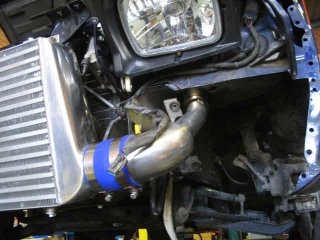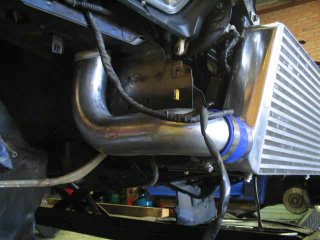Fitting a Nissan 180SX Intercooler & Vertex Frontbar
We have just fitted an intercooler and a Vertex fibreglass frontbar to a 180SX we have in stock. The frontbar has been sent for painting so I only have photos of the fitting of the intercooler at present but will post photos of the frontbar when fitted.


Most of you are probably aware of the huge difference an intercooler makes to a turbocharged car. As air is compressed (by the turbocharger), it increases in temperature thus reducing performance. An intercooler is fitted to reduce the temperature.

As you can see by the diagrams below, without an intercooler there would much less power gain due to the enormous heat generated by the turbo. Heat is the arch-enemy of any motor. This is the main reason why intercoolers are a vital part of any turbo kit. An intercooler is essentiall
 y a radiator tuned for high-volume flow rates and the increasing density of the charge as it cools. Lower air intake temperatures are safer for the motor, making air-to-air or air-to-liquid intercoolers vitally important. It is also crucial that they are mounted, so as to maximize air flow and promote efficient cooling.
y a radiator tuned for high-volume flow rates and the increasing density of the charge as it cools. Lower air intake temperatures are safer for the motor, making air-to-air or air-to-liquid intercoolers vitally important. It is also crucial that they are mounted, so as to maximize air flow and promote efficient cooling.The range of forced induction and the presence of spent exhaust gasses cause motors to generate enormous amounts of heat. An intercooler uses ambient air temperatures in the front of the moving vehicle to chill
 a core. The intake air temperature drops as the forced air from the turbo passes through this core. The resulting compressed air allows more air volume to enter the motor. The more air you can compress while keeping it at the same relative PSI, the more air you can force into your motor-providing more power and efficiency.
a core. The intake air temperature drops as the forced air from the turbo passes through this core. The resulting compressed air allows more air volume to enter the motor. The more air you can compress while keeping it at the same relative PSI, the more air you can force into your motor-providing more power and efficiency.A cooler engine will exhibit extended longevity and generate more horsepower. In addition, an intercooler protects against the expanding or warping of internal motor parts, which can lead to internal damage. Reducing the heat also decreases the tendency of the combustion process to knock (detonation).
More photos soon of the finished project.
Paul



